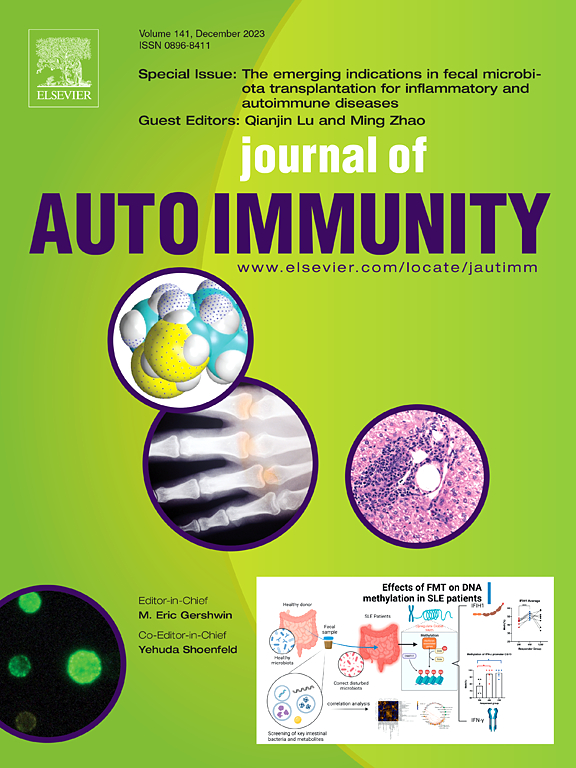Histological pattern of non-infectious thoracic aortitis impacts mortality
IF 7
1区 医学
Q1 IMMUNOLOGY
引用次数: 0
Abstract
Background
Non-infectious aortitis encompasses various histological patterns, but their specific cardiovascular outcomes remain unclear.
Objective
To evaluate the mortality associated with non-infectious surgical thoracic aortitis.
Methods
This retrospective multicenter study included patients who underwent thoracic aortic surgery and had histological evidence of aortitis. The study analyzed the characteristics of patients with non-infectious aortitis presenting either a granulomatous/giant cell histological pattern or a lymphoplasmacytic pattern. Factors associated with mortality were identified using multivariate analysis.
Results
Among 5666 patients who underwent thoracic aortic surgery, 197 were found to have non-infectious aortitis with either a granulomatous/giant cell histological pattern (n = 138) or a lymphoplasmacytic pattern (n = 59). The overall standardized mortality rate (SMR) for patients with non-infectious surgical thoracic aortitis was 1.61 (95 % CI: 1.05; 2.39), with 31.5 % of patients dying within 10 years of the initial procedure. After a median follow-up of 3.5 years [IQR: 0.5–6.8] post-surgery, 31 % of deaths were due to aortic dissection or rupture. The 10-year cumulative incidence of death was 40.1 % (95 % CI, 17.7–61.8) for patients with a granulomatous/giant cell pattern and 14.4 % (95 % CI, 2.6–35.6) for those with a lymphoplasmacytic pattern. Granulomatous/giant cell histological pattern (HR 4.71 [vs lymphoplasmacytic pattern]; 95 % CI, 1.37–16.2; p = 0.023) and aortic dissection at diagnosis (HR 6.07 [vs aneurysm]; 95 % CI, 2.89–12.7; p < 0.0001) were independently associated with increased mortality.
Conclusion
This multicenter study found that 31.5 % of patients with non-infectious surgical thoracic aortitis are expected to die within 10 years of their initial surgery. The granulomatous/giant cell histological pattern is associated with higher mortality.

非感染性胸主动脉炎的组织学类型影响死亡率。
背景:非感染性大动脉炎包括多种组织学类型,但其具体的心血管结局尚不清楚。目的:探讨非感染性外科胸主动脉炎的死亡率。方法:这项回顾性多中心研究纳入了接受胸主动脉手术并有大动脉炎组织学证据的患者。该研究分析了非感染性大动脉炎患者的特征,表现为肉芽肿/巨细胞组织学模式或淋巴浆细胞模式。使用多变量分析确定与死亡率相关的因素。结果:在接受胸主动脉手术的5666例患者中,197例发现非感染性大动脉炎伴有肉芽肿/巨细胞组织学模式(n = 138)或淋巴浆细胞模式(n = 59)。非感染性外科胸主动脉炎患者的总标准化死亡率(SMR)为1.61 (95% CI: 1.05;2.39), 31.5%的患者在初次手术后10年内死亡。术后中位随访3.5年[IQR: 0.5-6.8], 31%的死亡是由于主动脉夹层或破裂。肉芽肿/巨细胞型患者的10年累积死亡率为40.1% (95% CI, 17.7-61.8),淋巴浆细胞型患者的10年累积死亡率为14.4% (95% CI, 2.6-35.6)。肉芽肿/巨细胞型(HR 4.71 vs淋巴浆细胞型);95% ci, 1.37-16.2;p = 0.023)和诊断时主动脉夹层(HR 6.07 vs动脉瘤);95% ci, 2.89-12.7;结论:这项多中心研究发现,31.5%的非感染性外科胸主动脉炎患者预计在首次手术后10年内死亡。肉芽肿/巨细胞的组织学类型与较高的死亡率相关。
本文章由计算机程序翻译,如有差异,请以英文原文为准。
求助全文
约1分钟内获得全文
求助全文
来源期刊

Journal of autoimmunity
医学-免疫学
CiteScore
27.90
自引率
1.60%
发文量
117
审稿时长
17 days
期刊介绍:
The Journal of Autoimmunity serves as the primary publication for research on various facets of autoimmunity. These include topics such as the mechanism of self-recognition, regulation of autoimmune responses, experimental autoimmune diseases, diagnostic tests for autoantibodies, as well as the epidemiology, pathophysiology, and treatment of autoimmune diseases. While the journal covers a wide range of subjects, it emphasizes papers exploring the genetic, molecular biology, and cellular aspects of the field.
The Journal of Translational Autoimmunity, on the other hand, is a subsidiary journal of the Journal of Autoimmunity. It focuses specifically on translating scientific discoveries in autoimmunity into clinical applications and practical solutions. By highlighting research that bridges the gap between basic science and clinical practice, the Journal of Translational Autoimmunity aims to advance the understanding and treatment of autoimmune diseases.
 求助内容:
求助内容: 应助结果提醒方式:
应助结果提醒方式:


